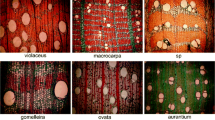Abstract
In order to identify wood surface types and carry out board grading, a collaborative classification method without image segmentation is proposed to sort four wood surface types: radial texture, tangential texture, live knot and dead knot. Firstly, three-level dual-tree complex wavelet decomposition is applied to the board image and 40-dimensional feature vector is obtained; secondly, particle swarm optimization (PSO) algorithm is used for feature selection and dimension reduction, and after optimization 11 key features are chosen; finally, the surface types are identified by compressed sensing classifier based on the features optimized by PSO. Four types of Xylosma samples are used for the experiment. The classification accuracy of the above four types are 100, 86.7, 96.7 and 86.7 %, respectively. Theoretical and experimental results show that the direction property of dual-tree complex wavelet can express the complex information of wood surface and the classification realized by compressed sensing is effective.






Similar content being viewed by others
References
Bai XB, Wang KQ, Wang H (2006) Research on the classification of wood texture based on gray-level co-occurrence matrix. J Harbin Inst Technol 37(12):1660–1670
Donoho DL (2006a) Compressed sensing. IEEE Trans Inf Theory 52(4):1289–1306
Donoho DL (2006b) For most large underdetermined systems of linear equations the minimal l1-norm near solution approximates the sparsest solution. Commun Pure Appl Math 59(6):797–829
Estévez PA, Perez CA, Goles E (2003) Genetic input selection to a neural classifier for defect classification of radiata pine boards. For Prod J 53(7/8):87–94
Kennedy J, Eberhart RC (1997) A discrete binary version of the particle swarm algorithm. Proc Conf Syst Man Cybern 5:4104–4108
Kingsbury NG (2001) Complex wavelets for shift invariant analysis and filtering of signals. J Appl Comput Harmonic Anal 10(3):234–253
Mahram A, Shayesteh MG, Jafarpour S (2012) Classification of wood surface defects with hybrid usage of statistical and textural features. In: IEEE 35th international conference on telecommunications and signal processing (TSP), pp 749–752
Pham DT, Alcock RJ (1999) Automated visual inspection of wood boards selection of features for defect classification by a neural network. Proc Inst Mech Eng 213(4):231–245
Russell S, Norvig P (2002) Artificial intelligence: a modern approach. Pearson Education, New Jersey
Ruz GA, Estévez PA, Ramírez PA (2009) Automated visual inspection system for wood defect classification using computational intelligence techniques. Int J Syst Sci 40(2):163–172
Shi HL, Hu B (2007) Survey of dual-tree complex wavelet transform and its applications. Inf Electr Eng 5(3):229–234
Shi GM, Liu DH, Gao DH, Liu Z, Lin J, Wang LJ (2009) Advance in theory and application of compressed sensing. Acta Electron Sin 37(5):1070–1081
Wang YQ, Wang H (2011) Application of rank GMRF in textural description and recognition. Comput Eng Appl 47(25):202–204
Wang H, Bai XB, Wang H (2007) Wood texture classification and recognition based on spatial GLCM. For Eng 23(1):32–36
Wang KQ, Bai XB, Wang H (2009) Classification of wood surface texture based on wavelets transform. J Harbin Inst Technol 41(9):232–234
Wright DJ, Yang AY, Ganesh A, Sastry SS, Ma Y (2009) Robust face recognition via sparse representation. IEEE Trans PAMI 31:210–227
Wu QT, Cao JB, Zheng RJ, Zhang JW (2013) Intrusion feature selection algorithm based on particle swarm optimization. Comput Eng Appl 49(7):89–92
Xiao B, Shu W (2011) Research on feature extraction of defects on wood surfaces based on image fusion. Comput Sci 38(4):282–285
Xiao SP, Chen YD, Yang JX (2009) Color texture recognition based on wavelet transform and support vector machine. Microelectron Comput 27(7):117–120
Yang FG, Sun TJ, Pang QL, Sun B (2006) Wood texture classification algorithm based on SVM and wavelet. Chin J Sci Inst 27(6):2250–2252
Zhang YZ, Ma L, Wang TB, Zhou HW (2013) Wavelet transform of wood texture online classification. For Sci Technol 37(6):21–24
Zhang YZ, Xu L, Ding L, Cao J (2014) Defects segmentation for wood floor based on image fusion method. Electric Mach Control 18(7):113–118
Zhang YZ, Xu C, Li C, Yu HL (2015) Wood defect detection method with PCA feature and compressed sensing. J For Res 26(3):745–751
Acknowledgments
The authors would like to thank the Forestry Public Welfare Project (201304510), Natural Science Foundation of Heilongjiang Province (C201405) (C2015054) and Heilongjiang Postdoctoral Research Fund (LBH-Q14014) for supporting this work.
Author information
Authors and Affiliations
Corresponding author
Rights and permissions
About this article
Cite this article
Zhang, Y., Liu, S., Cao, J. et al. Wood board image processing based on dual-tree complex wavelet feature selection and compressed sensing. Wood Sci Technol 50, 297–311 (2016). https://doi.org/10.1007/s00226-015-0776-y
Received:
Published:
Issue Date:
DOI: https://doi.org/10.1007/s00226-015-0776-y




